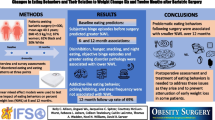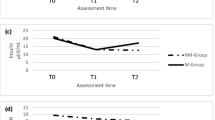Abstract
Background
A growing number of studies suggest that bariatric surgery is safe and effective for adolescents with severe obesity. However, surprisingly little is known about changes in dietary intake and eating behavior of adolescents who undergo bariatric surgery.
Objective
Investigate changes in dietary intake and eating behavior of adolescents with obesity who underwent bariatric surgery (n = 119) or lifestyle modification (LM) (n = 169).
Setting
University-based health systems
Methods
A prospective investigation of 288 participants (219 female and 69 male) prior to bariatric surgery or LM and again 6, 12, and 24 months (surgery patients only) after treatment. Measures included changes in weight, macronutrient intake, eating behavior, and relevant demographic and physiological variables.
Results
Adolescents who underwent bariatric surgery experienced significantly greater weight loss than those who received LM. The two groups differed in self-reported intake of a number of macronutrients at 6 and 12 months from baseline, but not total caloric intake. Patients treated with surgery, compared to those treated with LM, also reported significantly greater reductions in a number of disordered eating symptoms. After bariatric surgery, greater weight loss from postoperative month 6 to 12 was associated with self-reported weight consciousness, craving for sweets, and consumption of zinc.
Conclusions
Adolescents who underwent bariatric surgery, compared to those who received LM, reported significantly greater reductions in weight after 1 year. They also reported greater reductions in disordered eating symptoms. These findings provide new information on changes in dietary intake and eating behavior among adolescents who undergo bariatric surgery.

Similar content being viewed by others
References
Ogden CL, Carroll MD, Kit BK, et al. Prevalence and trends in body mass index among US children and adolescents 1999-2010. JAMA. 2012;307(5):483–90.
Daniels SR, Arnett DK, Eckel RH, et al. Overweight in children and adolescents: pathophysiology, consequences, prevention, and treatment. Circulation. 2005;111(15).
Zeller MH, Inge TH, Modi AC, et al. Severe obesity and comorbid condition impact on the weight-related quality of life of the adolescent patient. J Pediatr. 2015;166(3):651–9.
Sarwer DB, Dilks RJ. Invited commentary: childhood and adolescent obesity: psychological and behavioral issues in weight loss treatment. J Youth Adolesc. 2012;41(1):98–104.
Sarwer DB, Womble LG, Berkowitz RI. Behavioral treatment of obesity. In: Gumbiner B, editor. Obesity. Philadelphia: American College of Physicians; 2001. p. 179–95.
Sarwer DB, Butryn ML, Forman E, et al. Lifestyle modification for the treatment of obesity. In: Still CD, Sarwer DB, Blankenship J, editors. The ASMBS Textbook of bariatric surgery. Volume 2: integrative health. New York: Springer; 2014. p. 147–55.
Mechanick JI, Youdim A, Jones DB, et al. Clinical practice guidelines for the perioperative nutritional, metabolic, and nonsurgical support of the bariatric surgery patient—2013 update: cosponsored by American Association of Clinical Endocrinologists, the Obesity Society, and American Society for Metabolic Bariatric Surgery. Surg Obes Relat dis. 2013;9(2):159–91.
Inge TH, Courcoulas AP, Jenkins TM, et al. Weight loss and health status 3 years after bariatric surgery in adolescents. NEJM. 2016;374(2):113–23.
Inge TH, Zeller MH, Jenkins TM, et al. Perioperative outcomes of adolescents undergoing bariatric surgery: the Teen-Longitudinal Assessment of Bariatric Surgery (Teen-LABS) study. JAMA Pediatr. 2014;168(1):47–53.
Olbers T, Gronowitz E, Werling M, et al. Two-year outcome of laparoscopic Roux-en-Y gastric bypass in adolescents with severe obesity: results from a Swedish Nationwide Study (AMOS). Int J Obes. 2012;36(11):1388–95.
Sarwer DB, Lavery M, Spitzer JC. A review of the relationships between extreme obesity, quality of life, and sexual function. Obes Surg. 2012;22(4):668–76.
Sarwer DB, Dilks RJ, Ritter S, et al. Psychosocial considerations of the bariatric surgery patient. In: Herron DM, Sheiner D, editors. Insights into bariatric surgery, postoperative care and pregnancy. New York: Nova Science Publishers; 2013. p. 27–48.
Herpertz S, Kielmann R, Wolf AM, et al. Does obesity surgery improve psychosocial functioning? A systematic review. Int J Obes Relat Metab Disord. 2003;27(11):1300–14.
Sarwer DB, Allison KC, Bailer BA, et al. Psychosocial characteristics of bariatric surgery candidates. In: Still CD, Sarwer DB, Blankenship J, editors. The ASMBS Textbook of bariatric surgery. Volume 2: integrative health. New York: Springer; 2014. p. 3–9.
van Hout GC, van Oudheusden I, van Heck GL. Psychological profile of the morbidly obese. Obes Surg. 2004;14(5):579–88.
Sarwer DB, Wadden TA, Moore RH, et al. Preoperative eating behavior, postoperative dietary adherence, and weight loss after gastric bypass surgery. Surg Obes Relat dis. 2008;4(5):640–6.
Sarwer DB, Moore RH, Spitzer JC, et al. A pilot study investigating the efficacy of postoperative dietary counseling to improve outcomes after bariatric surgery. Surg Obes Relat dis. 2012;8(5):561–8.
Sjöström L, Lindroos AK, Peltonen M, et al. Lifestyle, diabetes, and cardiovascular risk factors 10 years after bariatric surgery. N Engl J med. 2004;351(26):2683–93.
Colles SL, Dixon JB, O'Brien PE. Hunger control and regular physical activity facilitate weight loss after laparoscopic adjustable gastric banding. Obes Surg. 2008;18(7):833–40.
Allison KC, Wadden TA, Sarwer DB, et al. Night eating syndrome and binge eating disorder among persons seeking bariatric surgery: prevalence and related features. Obesity. 2006;14(Suppl 2):77S–82S.
de Zwaan M, Mitchell JE, Howell LM, et al. Characteristics of morbidly obese patients before gastric bypass surgery. Compr Psychiatry. 2003;44(5):428–34.
Hsu LK, Betancourt S, Sullivan SP. Eating disturbances before and after vertical banded gastroplasty: a pilot study. Int J eat Disord. 1996;19(1):23–34.
Kalarchian MA, Marcus MD, Wilson GT, et al. Binge eating among gastric bypass patients at long-term follow-up. Obes Surg. 2002;12(2):270–5.
Chao AM, Wadden TA, Faulconbridge LF, et al. Binge-eating disorder and the outcome of bariatric surgery in a prospective, observational study: two-year results. Obesity. 2016;4(11):2327–233.
Kim RJ, Langer JM, Baker AW, et al. Psychosocial status in adolescents undergoing bariatric surgery. Obes Surg. 2008;18(1):27–33.
Inge TH, Zeller M, Harmon C, et al. Teen-Longitudinal Assessment of Bariatric Surgery: methodological features of the first prospective multicenter study of adolescent bariatric surgery. J Pediatr Surg. 2007;42(11):1969–71.
Widhalm K, Fritsch M, Wildhalm H, et al. Bariatric surgery in morbidly obese adolescents: long-term follow-up. Int J Pediatr Obes. 2011;6:65–9.
Johnson A, Reddy S, Walsh S, et al. The relationship between diet of adolescents before sleeve gastrectomy and success with weight loss and behavioral changes six months postsurgery. Bariatric Surgical Practice and Patient Care. 2016;11(1):15–9.
Utzinger LM, Gowey MA, Zeller M, et al. Loss of control eating and eating disorders in adolescents before bariatric surgery. Int J eat dis. 2016;49(10):947–52.
Cushing CC, Peugh JL, Brode CS, et al. Longitudinal trends in food cravings following Roux-en-Y gastric bypass in an adolescent sample. Surg Obes Relat dis. 2015;11(1):14–8.
Berkowitz RI, Rukstalis MR, Bishop-Gilyard CT, et al. Treatment of adolescent obesity comparing self-guided and group lifestyle modification programs: a potential model for primary care. J Pediatr Psych. 2013;38(9):978–86.
Stefater MA, Jenkins T, Inge TH. Bariatric surgery for adolescents. Pediatr Diabetes. 2013;14(1):1–12.
Michalsy MP, Inge TH, Teich S, et al. Adolscent bariatric surgery program characteristics: the Teen Longitudinal Assessment of Bariatric Surgery (Teen-LABS) study experience. Semin Pediatr Surg. 2014;23(1):5–10.
Dixon L. The Minnesota Nutrition Data System: A tool designed by researchers for researchers. In: Society for Nutrition Education; 1996; 1996.
Modi AC, Zeller MH, Xanthakos SA, et al. Adherence to vitamin supplementation following adolescent bariatric surgery. Obesity. 2013;21(3):E190–5.
Stunkard AJ, Messick S. Eating inventory manual. San Antonio: Harcourt Brace Jovanovitch, Inc.; 1988.
Fairburn CG, Cooper Z. The eating disorder examination. In: Fairburn CG, Wilson GT, editors. Binge eating: nature, assessment, and treatment. 12th ed. New York: Guilford; 1993. p. 317–32.
Wilson GT. Assessment of binge eating. In: Fairburn CG, Wilson GT, editors. Binge eating: nature, assessment and treatment. New York: Guilford Press; 1993. p. 227–49.
Vander Wal JS, Stein RI, Blashill AJ. The EDE-Q, BULIT-R, and BEDT as self-report measures of binge eating disorder. Eat Behav. 2011;12(4):267–71.
Allison KC, Lundgren JD, O'Reardon JP, et al. The Night Eating Questionnaire (NEQ): psychometric properties of a measure of severity of the night eating syndrome. Eat Behav. 2008;9(1):62–72.
Harb A, Levandovski R, Oliveira C, et al. Night eating patterns and chronotypes: a correlation with binge eating behaviors. Psychiatry res. 2012;200(2–3):489–93.
White MA, Whisenhunt BL, Williamson DA, et al. Development and validation of the food craving inventory. Obes res. 2002;10(2):107–14.
Littell RC, Milliken GA, Stroup WW, et al. SAS System for Mixed Models. Cary: SAS Institute Inc.; 1996. 633 pp
Pinheiro J, Bates DM. Mixed effects models in S and S-plus. New York: Springer-Verlag; 2000.
Harbury CM, Verbruggen EE, Callister R, et al. What do individuals with morbid obesity report as usual dietary intake? A narrative review of available evidence. Clin Nutr. 2016;13:e15–22.
NHANES data 2005–2006 drawn from analyses of usual dietary intakes conducted by the National Cancer Institute. http://riskfactor.cancer.gov/diet/foodsources/.
Pratt JS, Lenders CM, Dionne EA, et al. Best practice updates for pediatric/adolescent weight loss surgery. Obesity (Silver Spring). 2009;17(5):901–10.
Savage JS, Mitchell DC, Smiciklas-Wright H, et al. Plausible reports of energy intake may predict body mass index in pre-adolescent girls. J am Diet Assoc. 2008;108(1):131–5.
Bailey RL, Mitchell DC, Miller C, et al. Assessing the effect of underreporting energy intake on dietary patterns and weight status. J am Diet Assoc. 2007;107(1):64–71.
Poslusna K, Ruprich J, de Vries JH, et al. Misreporting of energy and micronutrient intake estimated by food records and 24 hour recalls, control and adjustment methods in practice. Br J Nutr. 2009;101(Suppl 2):S73–85.
Ventura AK, Loken E, Mitchell DC, et al. Understanding reporting bias in the dietary recall data of 11-year-old girls. Obesity (Silver Spring). 2006;14(6):1073–84.
LoMenzo E, Szomstein S, Rosenthal RJ. Mechanism of Action of the Bariatric Procedures. In: Nguyen, NT, Blackstone RP, Morton JM, Ponce J, Rosenthal RJ (Eds). The ASMBS Textbook of Bariatric Surgery. 1: 61–72, 2014.
Sarwer DB, Spitzer JC, Wadden TA, et al. Sexual functioning and sex hormones in men who underwent bariatric surgery. Surg Obes Relat dis. 2015;11(3):643–51.
Sarwer DB, Spitzer JC, Wadden TA, et al. Sexual functioning and sex hormones in persons with extreme obesity and seeking surgical and nonsurgical weight loss. Surg Obes Relat dis. 2013;9(6):997–1007.
Sarwer DB, Spitzer JC, Wadden TA, et al. Changes in sexual functioning and sex hormone levels in women following bariatric surgery. JAMA Surg. 2014;149(1):26–33.
U.S. Department of Agriculture, Agricultural Research Service. 2011. USDA National Nutrient Database for Standard Reference, Release 24. Nutrient Data Laboratory Home Page, http://www.ars.usda.gov/ba/bhnrc/ndlexternal link disclaimer.
Ishikawa Y, Kudo H, Kagawa Y, et al. Increased plasma levels of zinc in obese adult females on a weight-loss program based on a hypocaloric balanced diet. In Vivo. 2005;19(6):1035–7.
Author information
Authors and Affiliations
Corresponding author
Ethics declarations
Funding
Work on this paper was supported, in part, by the National Institute of Diabetes and Digestive and Kidney Diseases (Grants R01-DK080738 to Dr. Sarwer and K24-DK065018 to Dr. Wadden and U01DK072493 to Dr. Inge), the Pennsylvania Department of Health SAP4100033130 to Dr. Berkowitz, and the Clinical & Translational Research Center at the University of Pennsylvania and The Children’s Hospital of Philadelphia supported by grants UL1RR024134 (NCRR) and UL1TR000003 (NCATS).
Conflict of Interest
Author A reports received consulting fees from the following: BARONova, Ethicon Endosurgery, Medtronic, and Novo Nordisk. Author B reports receiving fees for serving on the Advisory Board for Orexigen Pharmaceutical and Nutrisystem. He reports receiving grants and advisory board fees from Novo Nordisk and Weight Watchers. He also reports receiving grant funding from Eisai Pharmaceutical and royalties from Guilford Press for two edited books. Author C reports consulting fees from Sanofi Corporation and grant funding from Ethicon Endosurgery.
Rights and permissions
About this article
Cite this article
Sarwer, D.B., Dilks, R.J., Spitzer, J.C. et al. Changes in Dietary Intake and Eating Behavior in Adolescents After Bariatric Surgery: an Ancillary Study to the Teen-LABS Consortium. OBES SURG 27, 3082–3091 (2017). https://doi.org/10.1007/s11695-017-2764-9
Published:
Issue Date:
DOI: https://doi.org/10.1007/s11695-017-2764-9




